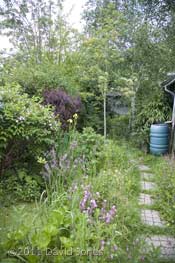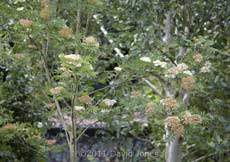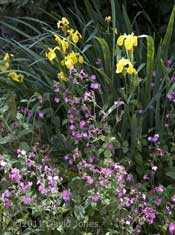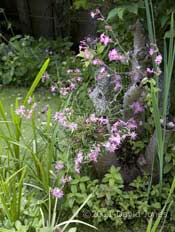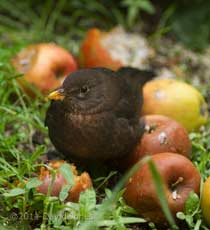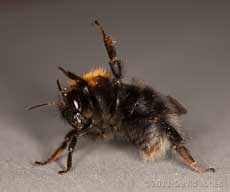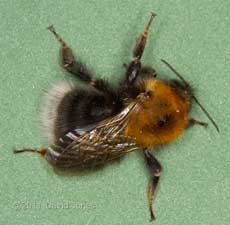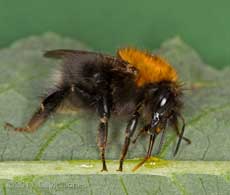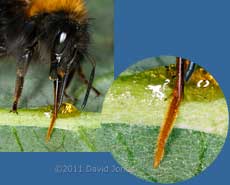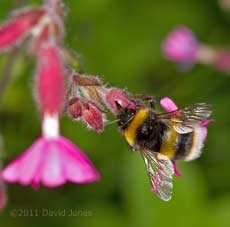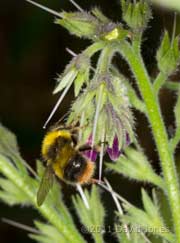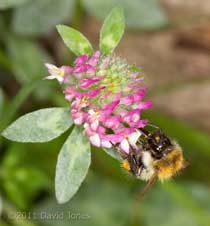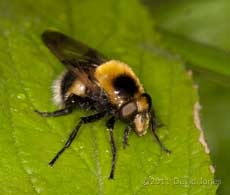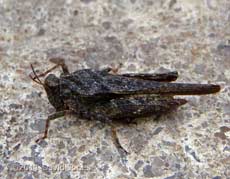Go to the last entry on this page .....Go to previous entry22 May - Home again! After a journey along roads much busier with holiday traffic than they were two weeks ago we were back home by the middle of the afternoon. I've uploaded a holiday diary, although I will need to check through it again, and add a couple of updates. Also, I see that several of the photographs look very dark and need reprocessing.
23 May - A few pictures to show changes seen on our return.
As expected, the garden now looks more like some of the Cornish hedgerows - I will take a better look tomorrow, although I have already spotted some young bush crickets that weren't visible before we headed for Cornwall.
When we left the Rowan had opened its first clusters of flowers. On our return it was the last inflorescences that were still in bloom with the rest now a dull colour.
Before the holiday the Irises had only a few tightly closed flower buds, but they seem to have begun flowering within the last few days of the trip. And there are Red Campions almost everywhere,
although around the edge of the pond the Ragged Robins have also come into bloom. This picture shows one cluster actually growing out of the log in the middle of the pond. In order to ensure the survival of this plant during the dry weather prior to the holiday I needed to water the log quite often as it stands on a stone rather than in the water itself.
25 May - The problems with our holidays is that there is so much to sort out on our return! With just about everything else now put away, bright, warm (19C max) and breezy weather has allowed me to wash and dry all my kayaking gear today. I have still to point a camera out into the garden, but today I saw a Cream-spot Ladybird on a Garlic Mustard plant, along with several 14-spot Ladybirds in the same area. While I haven't seen any Harlequin Ladybirds in the garden, the Rosa rugosa plants at the front of the house is playing host to at least ten of their nymphs. While I was dealing with the kayak things a large dragonfly appeared over the big pond and landed long enough for me to get a good look at it - a Broad-bodied Chaser (Libellula depressa). While it is a common species I think it's a first time sighting in our garden. It would have made a good photograph.
29 May - It seems that our decision to return home last Sunday was a good one as the weather since then hasn't been so good. having said that, we are still waiting for some decent amounts of rain. Today has been dry with some pleasant spells of sunshine and a high of 19C, although that was during the late morning. The last few days have been quite busy so photography has had to await its turn. However, a couple of things to note - Early in the week there was a family of Blue Tits with fledglings making quite a noise at the bottom of the garden. Over the last two days they were replaced by a small flock of equally noisy Long-tailed Tits, but there was no sign of either today.
One bird that has made appearances every day this week is this young Blackbird that appears addicted to a group of rotting apples that I put out near the veranda. Just about every time we go out of the Kitchen door it scurries off under the Hawthorn. On this occasion I spotted it sitting in the middle of them and had time to get a step ladder from upstairs to take this photograph through a window.
During the late morning I happened to look down as I walked down the shaded side of our driveway and spotted a bumblebee that was grounded and clearly in need of warming up.
I gathered it up with a leaf and placed it in a sheltered spot to await the sunshine that would emerge pretty soon as the clouds moved by. Despite not being able to fly its reaction was to adopt the classic bumblebee threat posture, raising two legs and pointing its sting in my direction!
As it took time to calm down and warm up I had chance to check my Bumblebee book and identify it as (I believe) Bombus hypnorum. This is a species that wasn't recording in the UK until 2001 and which has since spread in south and south-east England. It's not a species that I've seen in the garden previously.
While we waited for the sun to appear I resorted to mixing a bit of honey into a drop of rainwater and offering this to the bee, and it wasn't long before it was quiet literally lapping the drink up.
The tongue itself is a hairy structure that offers a very large surface area for the quick absorption of nectar, and also contain sensory receptors to taste and smell. When not in use this delicate structure is hidden within a sheath formed by the maxillae (jaws) and palps. The palps are also sensory organs and you can see them at the lower end of the sheath.
Once I had my camera out I decided to take a look at a few of the other bumblebees that are frequenting the garden at the moment.
The most common species the afternoon seemed to be Bombus lucorum, the White-tailed Bumblebee, the workers of which were concentrating on the Red Campions. These flowers with their long corolla would not seem to be the best source of nectar for a bumblebee with a relatively short tongue, but this species gets around the problem by biting a hole low down the flower through which they can then feed, and you can see them heading for the holes as they make return trips to the flowers.
The Comfrey flowers were the food source for a different species, the Early-nesting Bumblebee (Bombus pratorum). These were smaller bees with an orange tail. Occasionally I would seem them feed at the opening of a flower, but on most visits they took advantage of holes bitten in the flower by bees of another species.
The only other species I caught on camera this afternoon was this bee on the Red Clover. Unfortunately I couldn't get a better view than this. It may well be a Common Carder Bee (Bombus pasuorum) but I'm not sure about the amount of white that I can see. There were others of this species in the garden but on the ones I got close to the white was less pronounced.
I also saw a Red-tailed Bumblebee (Bombus lapidarius) but didn't get close enough to photograph it.
Finally, a pretty good bumblebee mimic that made just a brief appearance today, and which is probably Volucella bombylans, a hoverfly that bears a resemblance to the White-tailed Bumblebee photographed above.
30 May - A day that started pleasantly enough to spend much of the morning (maximum temperature 18C) in my grand-daughters' garden but deteriorated quickly in the afternoon to give us overcast skies and drizzle, with the temperature dropping to 11C by 7pm.
That time was well spent with the little ones, with Erin delighting in taking a closer look at anything that moves. The 'eye on stalks' of a snail were a big attraction, as were the high speed jumps of what I first thought was a type of grasshopper. It looks like a Slender Groundhopper (Tetrrix subulata), a species that I've not seen in our garden.
Click on images to see larger version
|
|
